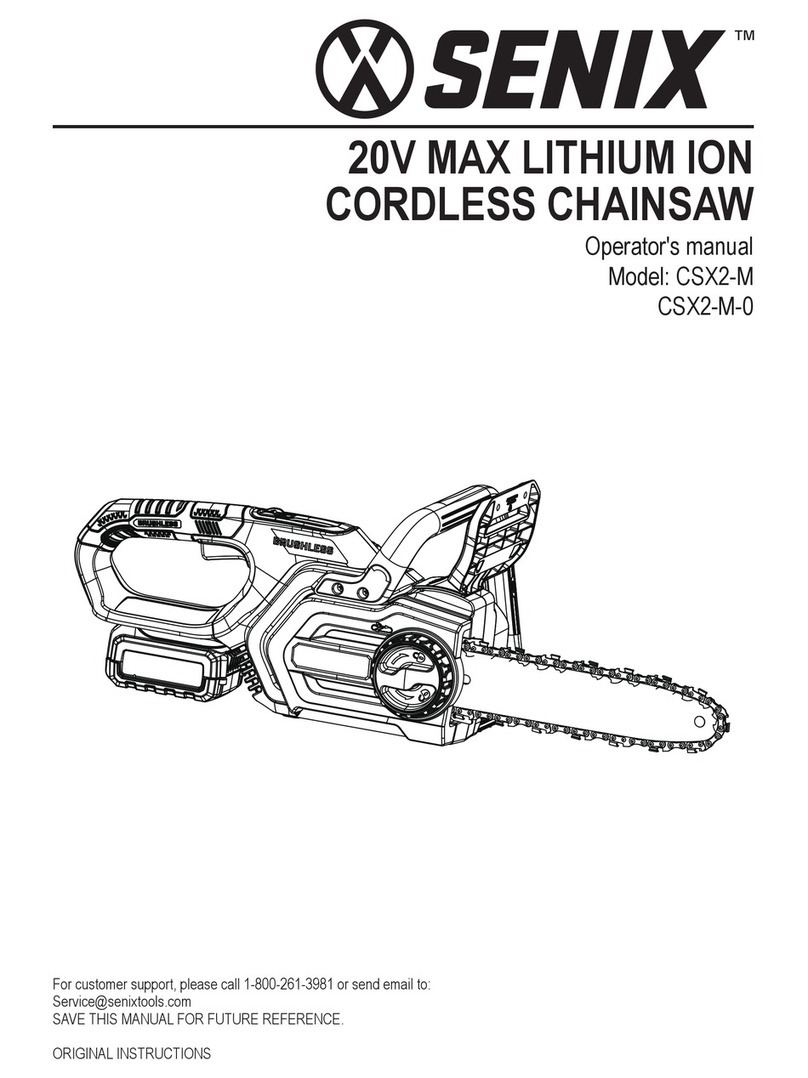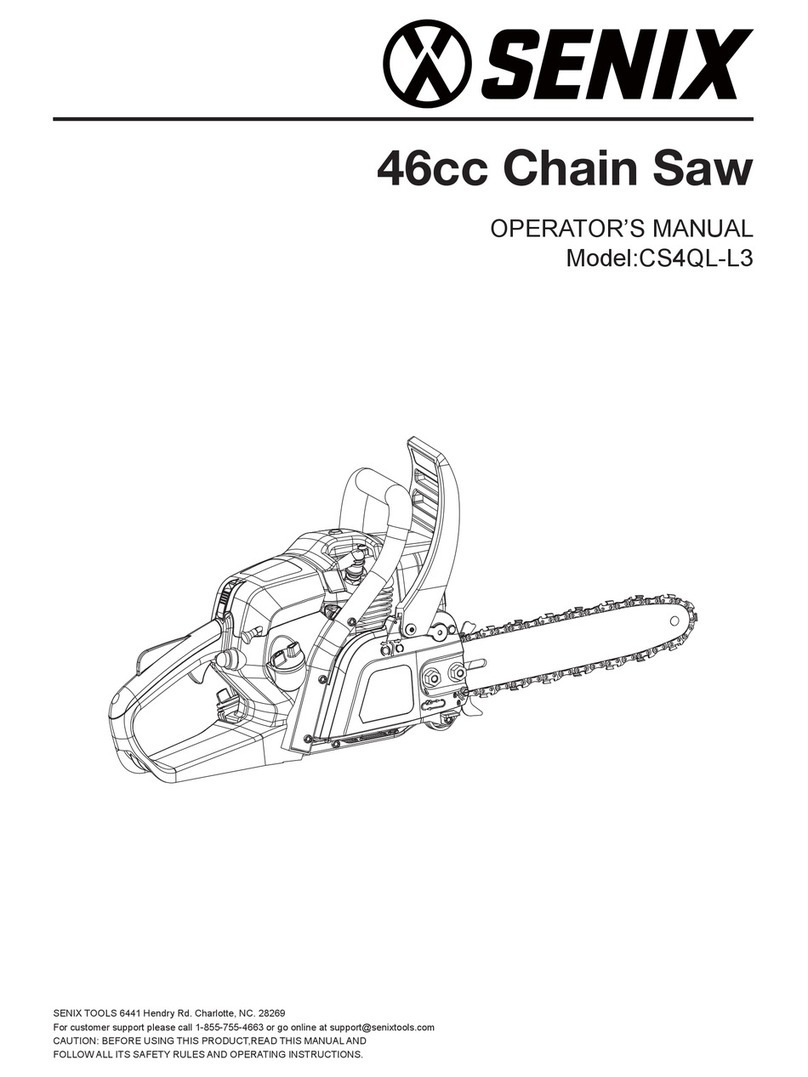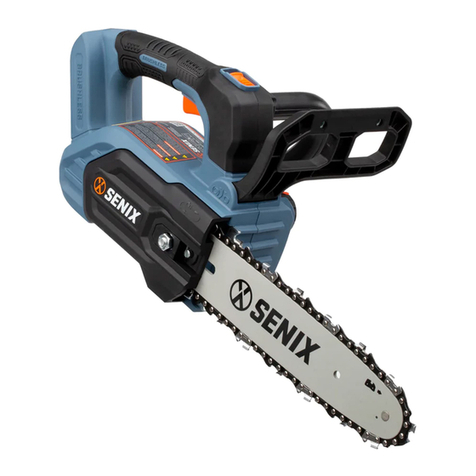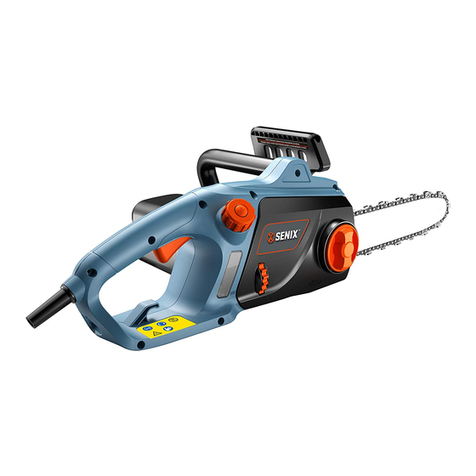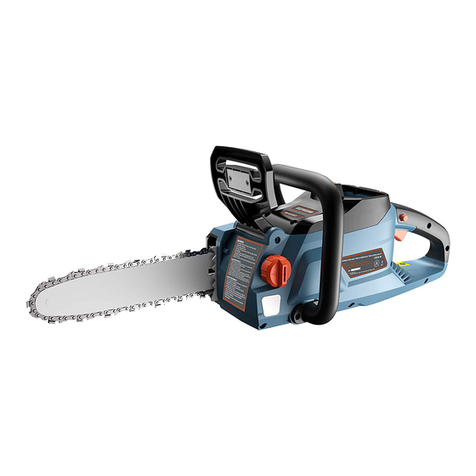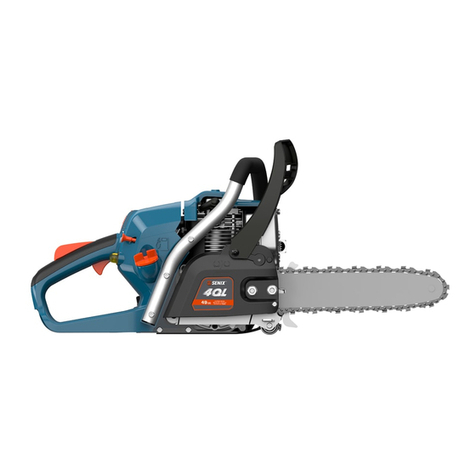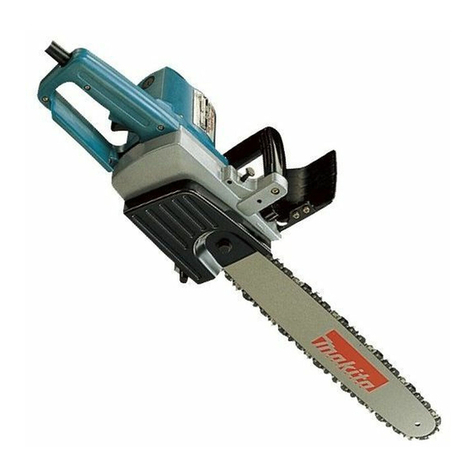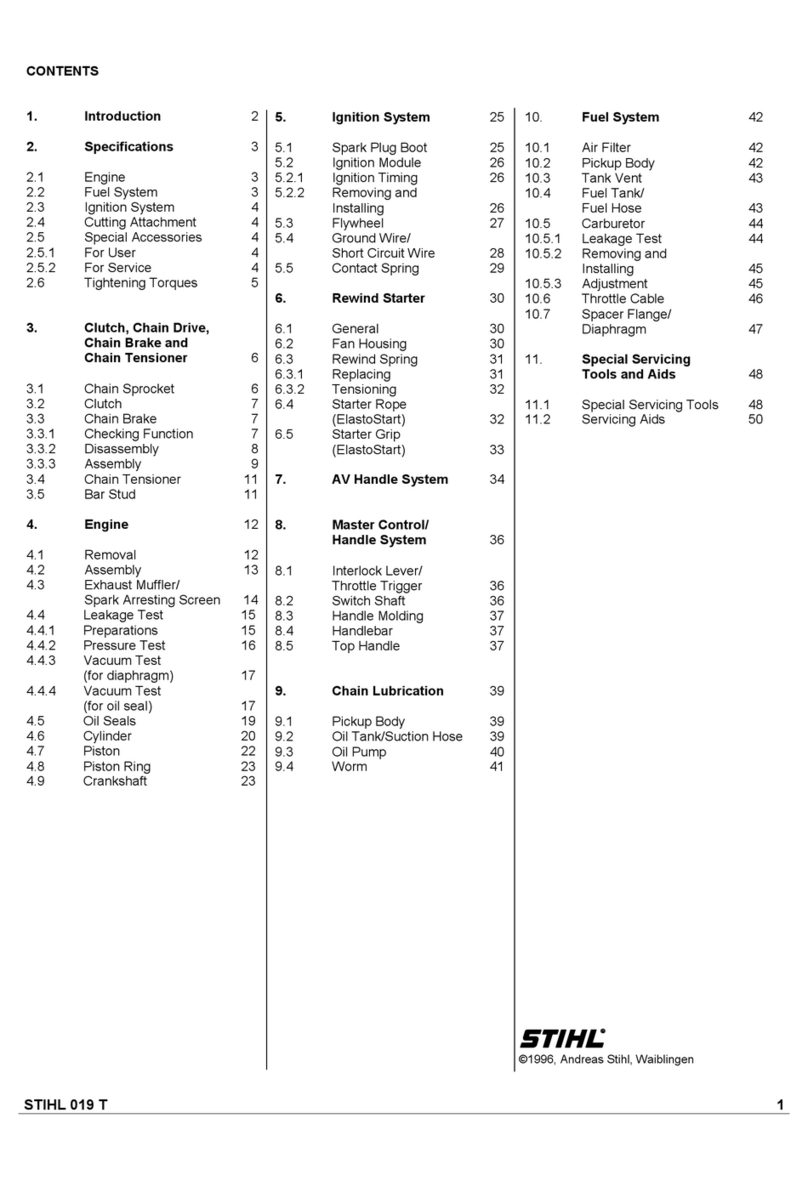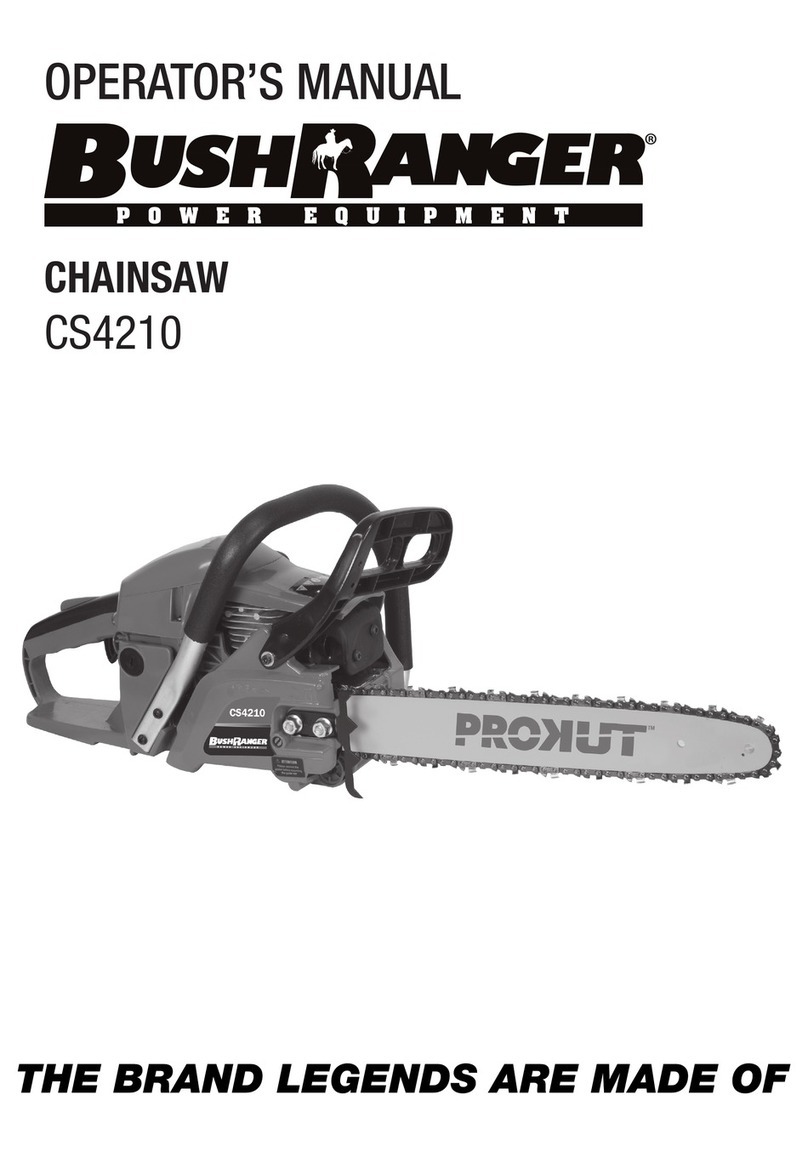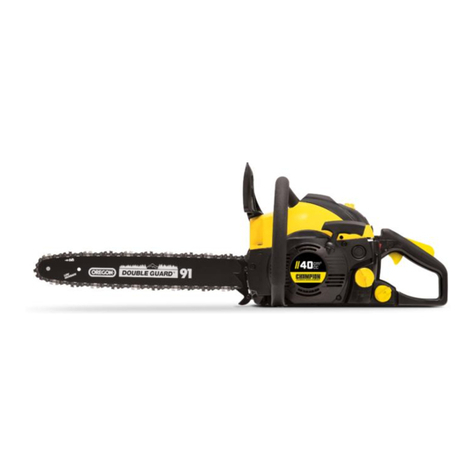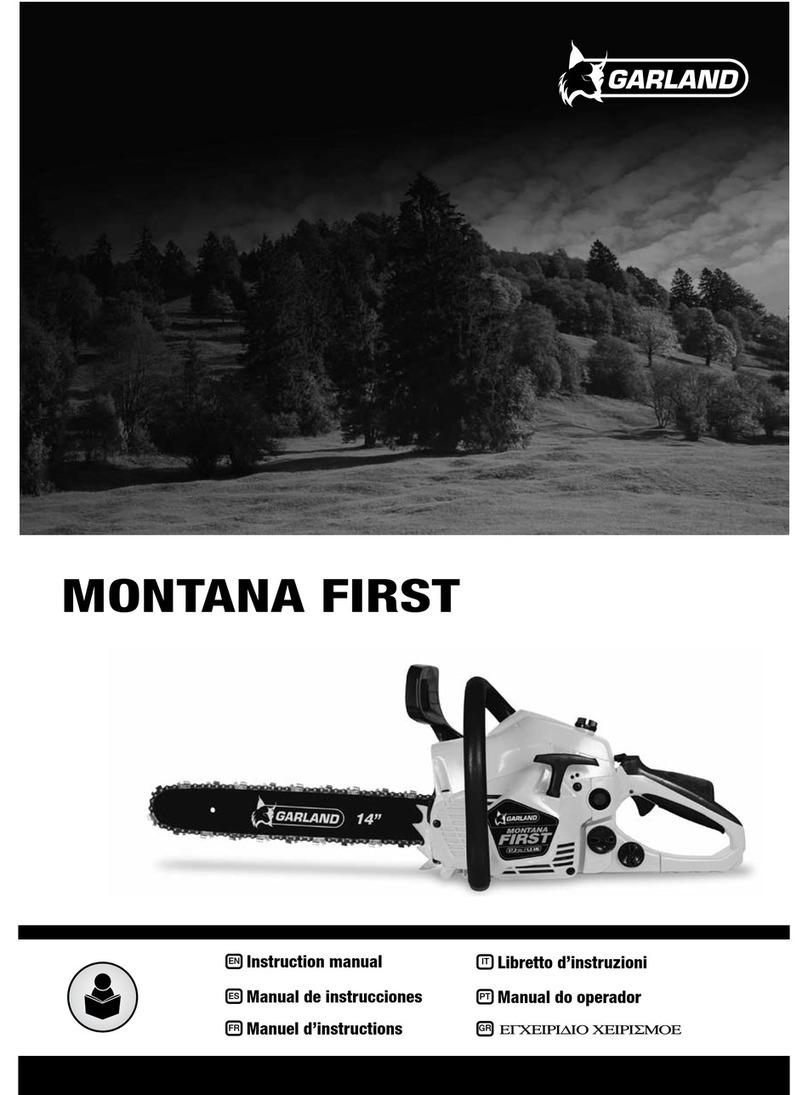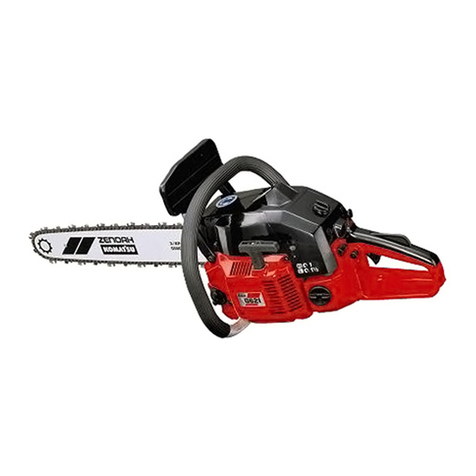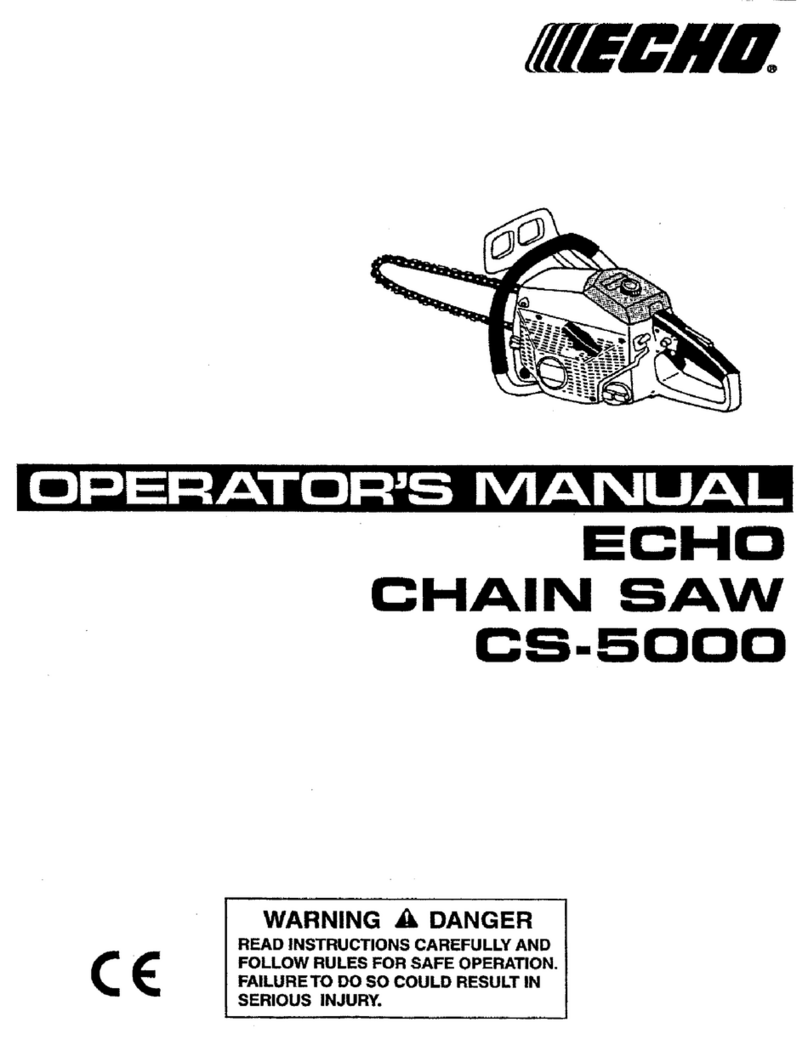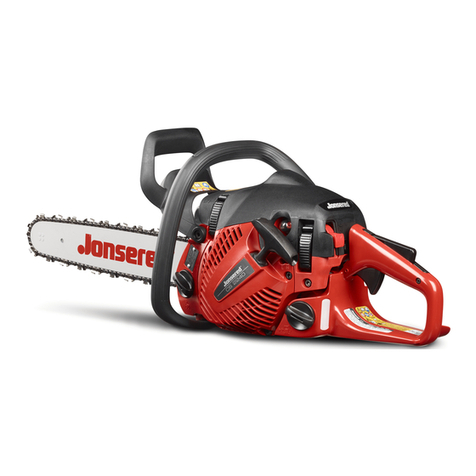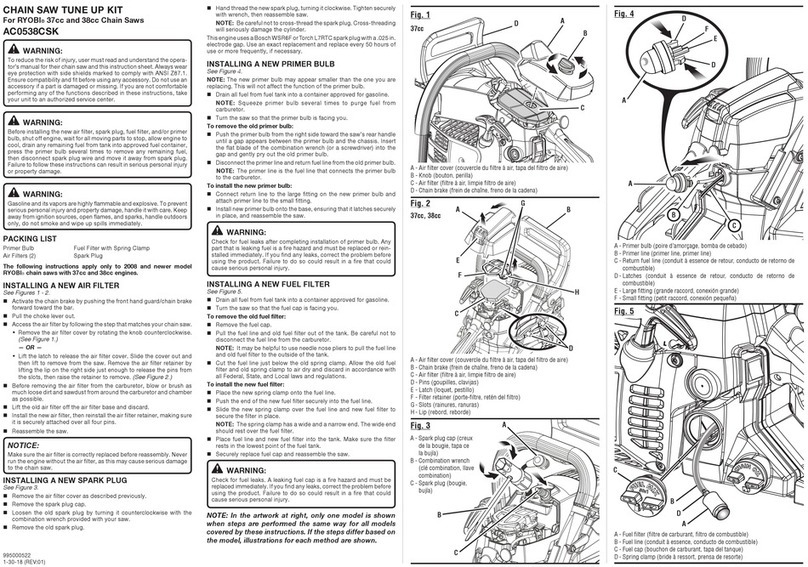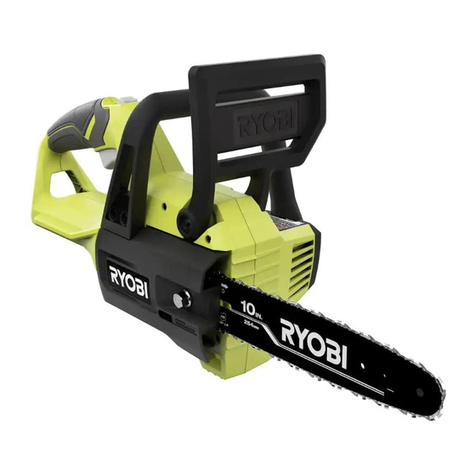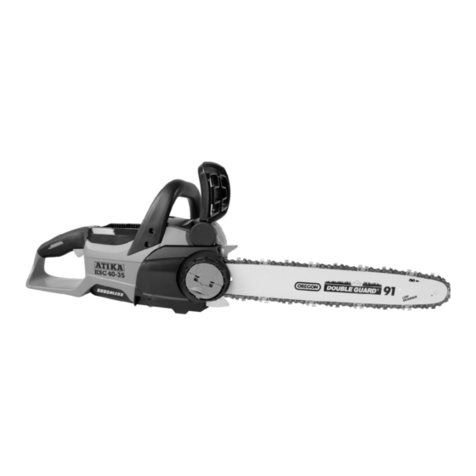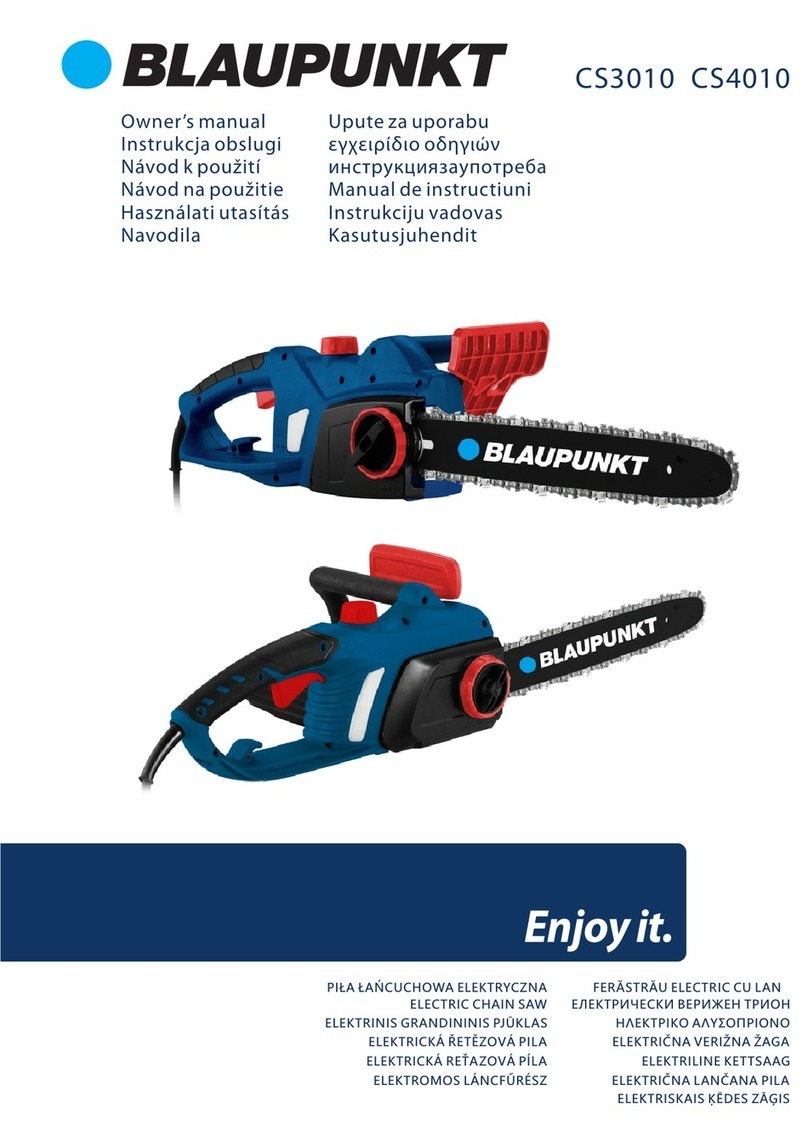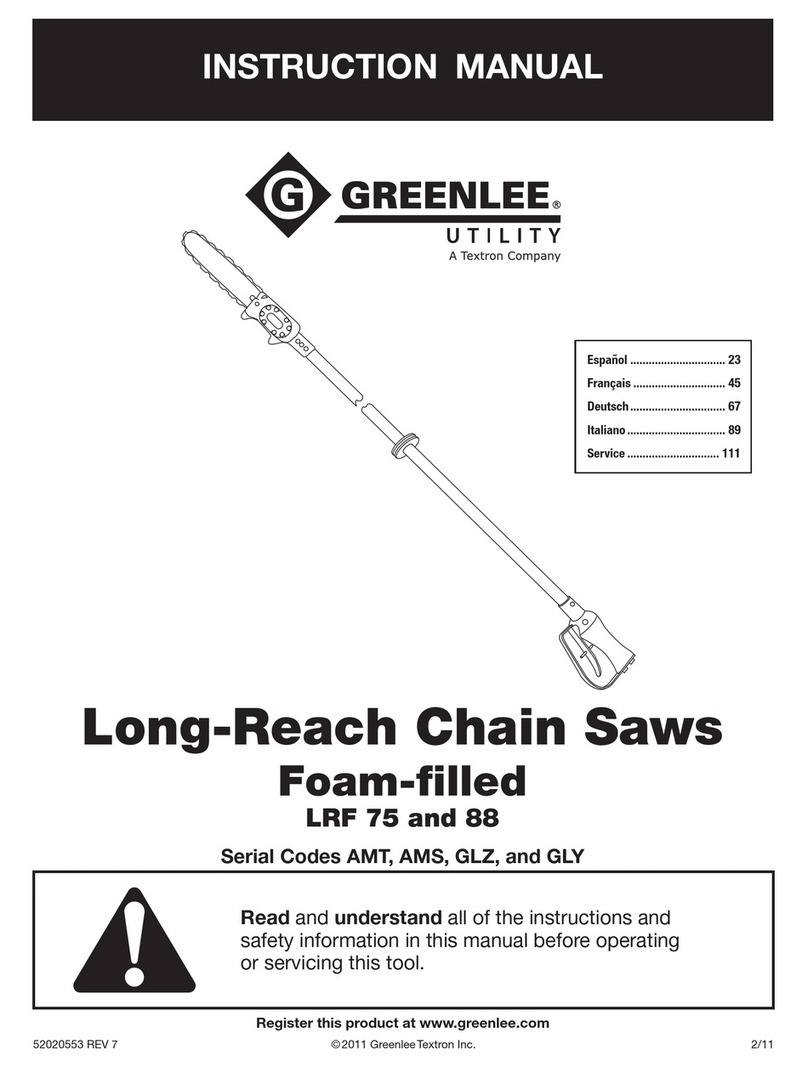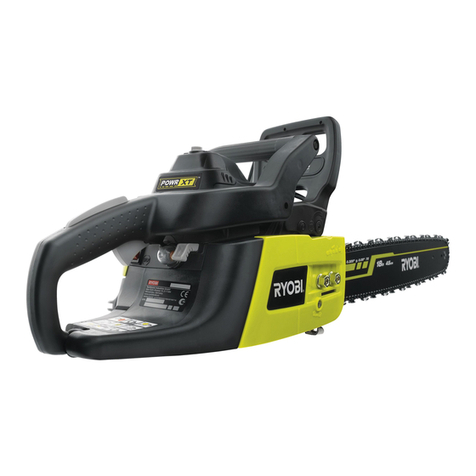Senix CSX5-M User manual


2WWW.SENIXTOOLS.COM
SAFETY SYMBOLS................................................2
TECHNICAL DATA..................................................3
GENERAL POWER TOOL SAFETY WARNINGS....4
VIBRATION AND NOISE REDUCTION...................7
EMERGENCY..........................................................8
RESIDUAL RISKS.................................................8
To reduce the risk of injury, user must
read instruction manual.
Wear ear protection.
Wear eye protection.
Wear dust mask.
Wear hand protection.
Wear non-slip safety footwear.
Failure to keep your hands away
from the blade will result in serious
personal injury .
Avoid power lines, use in dry
conditions .
Do not expose to rain.
DANGER!
Risk of electrocution!
Thrown objects can ricochet and result
in personal injury or property damage.
Keep all bystanders at least 50 ft.
away.
Indicates danger, warning or caution.
Precautions that involve your safety.
Contact of the guide bar tip with any
object should be avoided.
Tip contact can cause the guide bar
to to move suddenly upward and
backward,which can cause serious
injury.
FELLING A TREE..................................................9
FELLING BACK A CUT..........................................10
LIMBING A TREE..................................................10
BUCKING A LOG..................................................10
ATTACH /REMOVE THE BATTERY......................15
PREPARATION......................................................15
DURING OPERATION...........................................15
SAFETY WARNIGS...............................................15
ON/OFF SWITCH..................................................15
CHAIN BRAKE......................................................16
CLEANING.............................................................17
REPLACING THE CHAIN.......................................17
FILLING THE AUTO OIL SYSTEM..........................18
SPROCKET WHEEL MAINTENANCE..................18
GUIDE BAR AND CHAIN MAINTENANCE..............18
STORAGE.............................................................19
PARTS...................................................................20
Troubleshooting Table............................................21
Troubleshooting Table............................................23
KNOW YOUR CHAINSAW.....................................12
TENSIONING THE CHAIN.....................................13
ASSEMBLY OF GUIDE BAR AND SAW CHAIN.....13
FILLING THE OIL TANK........................................14
Always use two hands when
operating the chain saw.

3
WWW.SENIXTOOLS.COM
Model Number:
Motor:
No Load Speed:
Max. Chain Speed:
Oil Tank Capacity:
Guide Bar Model:
Battery/Charger:
Battery:
Weight (w/Battery):
Product Dimensions:
Model Number:
Motor:
No Load Speed:
Max. Chain Speed:
Oil Tank Capacity:
Guide Bar Model:
Battery/Charger:
Battery:
Weight (w/o Battery):
Product Dimensions:
CSX5-M
58V Brushless Motor
7300 RPM
49 FPS (Feet Per Second)
4.1 oz. (120 ml)
140SDEA041
Senix B25X5/CHX5
58V Max Lithium Ion, 2.5 Ah
10.88 lbs.
30.6 x 8.4 x 9.6 in.
356 mm (14 inch)
Some dust created by power sanding, sawing, grinding, drilling and other
construction activities contains chemicals known to the state of California
to cause cancer, birth defects or other reproductive harm. Some examples
of these chemicals are: Lead from lead-based paints, crystalline silica from
bricks and cement and other masonry products, and arsenic and chromium
from chemically treated lumber.
Your risk from these exposures varies, depending on how often you do this
type of work. To reduce your exposure to these chemicals, work in a well
ventilated area with approved safety equipment such as dust masks that are
This product can expose you to chemicals including lead, a chemical
known to the State of California to cause cancer and birth defects or other
reproductive harm. For more information go to www.P65Warnings.ca.gov.
140SDEA041 91P052X Oregon Cutting System
CSX5-M-O
58V Brushless Motor
7300 RPM
49 FPS (Feet Per Second)
4.1 oz. (120 ml)
140SDEA041
battery and charger not included
58V Max Lithium Ion, 2.5 Ah
8.68 lbs.
30.6 x 8.4 x 9.6 in.

4WWW.SENIXTOOLS.COM
The term “power tool” in the
warnings refers to your mains-
operated (corded) power tool or
battery-operated (cordless) power
tool.
Cluttered or dark areas invite
accidents.
Power tools create sparks
which may ignite the dust or
fumes.
Distractions can cause you
to lose control.
Unmodified plugs and matching
outlets will reduce risk of electric
shock.
There
is an increased risk of electric
shock if your body is earthed or
grounded.
Water entering a power tool
will increase the risk of electric
shock.
Damaged or
entangled cords increase the risk
of electric shock.
Use of a cord suitable for outdoor
use reduces the risk of electric
shock.
Use
of an RCD reduces the risk of
electric shock.
A moment of
inattention while operating
power tools may result in serious
personal injury.
Protective equipment
such as dust mask, non-skid
safety shoes, hard hat, or hearing
protection used for appropriate
conditions will reduce personal
injuries.
Carrying power tools
with your finger on theswitch or

5
WWW.SENIXTOOLS.COM
energising power tools that have
the switch on invites accidents.
A wrench or a
key left attached to a rotating part
of the power tool may result in
personal injury.
This enables better
control of the power tool in
unexpected situations.
Loose clothes, jewellery
or long hair can be caught in
moving parts.
Use of
dust collection can reduce dust-
related hazards.
The correct
power tool will do the job better
and safer at the rate for which it
was designed.
Any power tool that cannot
be controlled with the switch is
dangerous and must be repaired.
Such preventive
safety measures reduce the
risk of starting the power tool
accidentally.
Power tools are
dangerous in the hands of
untrained users.
Many accidents are caused
by poorly maintained power tools.
Properly maintained
cutting tools with sharp cutting
edges are less likely to bind and
are easier to control.
g.
Use of the power
tool for operations different from
those intended could result in a
hazardous situation.
A charger that is suitable for one
type of battery pack may create
a risk of fire when used with
another battery pack.
Use of any other battery
packs may create a risk of injury
and fire.
Shorting the battery terminals
together may cause burns or a
fire.

6WWW.SENIXTOOLS.COM
Liquid
ejected from the battery may
cause irritation or burns.
This will
ensure that the safety of the
power tool is maintained.
A moment of inattention while
operating chain saws may cause
entanglement of your clothing or
body with the saw chain.
Holding the
chain saw with a reversed hand
configuration increases the risk of
personal injury and should never
be done.
For chain saws designed with
the guide bar on the left side, the
reference to “right hand” and “left
hand” positioning is reversed.
may make exposed metal parts
give the operator an electric
shock.
Adequate
protective clothing will reduce
personal injury by flying debris or
accidental contact with the saw
chain.
Operation of a chain saw
while up in a tree may result in
personal injury.
Slippery
or unstable surfaces such as
ladders may cause a loss of
balance or control of the chain
saw.
When the tension
in the wood fibres is released the
spring loaded limb may strike the
operator and/or throw the chain
saw out of control.
The slender material may catch
the saw chain and be whipped
toward you or pull you off
balance.
Proper handling of the chain
saw will reduce the likelihood
of accidental contact with the
moving saw chain.
Improperly tensioned or
lubricated chain may either
break or increase the chance for
kickback.

7
WWW.SENIXTOOLS.COM
Greasy, oily handles are slippery
causing loss of control.
Use of the
chain saw for operations different
than intended could result in a
hazardous situation.
Kickback may occur when the nose
or tip of the guide bar touches an
object, or when the wood closes in
and pinches the saw chain in the
cut.
Tip contact in some cases may
cause a sudden reverse reaction,
kicking the guide bar up and back
towards the operator.
Pinching the saw chain along the
top of the guide bar may push the
guide bar rapidly back towards the
operator.
Either of these reactions may cause
you to lose control of the saw which
could result in serious personal
injury. Do not rely exclusively upon
the safety devices built into your
saw. As a chain saw user, you
should take several steps to keep
your cutting jobs free from accident
or injury.
Kickback is the result of tool
misuse and/or incorrect operating
procedures or conditions and
can be avoided by taking proper
precautions as given below:
Kickback
forces can be controlled by the
operator, if proper precautions are
taken. Do not let go of the chain
saw.
This helps prevent unintended tip
contact and enables better control
of the chain saw in unexpected
situations.
Incorrect
replacement bars and chains may
cause chain breakage and/or
kickback.
Decreasing the depth gauge
height can lead to increased
kickback.
To reduce the impact of noise and
vibration emission, limit the time of
operation, use low-vibration and low-
noise operating modes as well as
wear personal protective equipment.
Take the following points into
account to minimize the vibration
and noise exposure risks:
• Only use the product as
intended by its design and these
instructions.
• Ensure that the product is in good
condition and well maintained.
• Use correct attachments for the
product and ensure they are in
good condition.
• Keep tight grip on the handles/
gripping surface.
• Maintain this product in
accordance with these instructions
and keep it well lubricated (where
appropriate).
• Plan your work schedule to spread
any high vibration tool use across
a longer period of time.
• Prolonged use of the product
exposes the user to vibrations that
can cause a range of conditions
collectively known as hand-arm
vibration syndrome (HAVS) e.g.
fingers going white; as well as

8WWW.SENIXTOOLS.COM
specific diseases such as carpal
tunnel syndrome.
• To reduce this risk when using the
product, always wear protective
gloves and keep your hands
warm.
• The symptoms of HAVS include
any combination of the following:
Tingling and numbness in the
fingers; Not being able to feel
things properly; Loss of strength
in the hands; Fingers going white
(blanching) and becoming red and
painful on recovery (particularly
in the cold and wet, and probably
only in the tips at first).
Seek medical advice immediately if
such symptoms are experienced.
• Familiarize yourself with the use
of this product by means of this
instruction manual. Memorize
the safety directions and follow
them to the letter. This will help to
prevent risks and hazards.
• Always be alert when using this
product, so that you can recognize
and handle risks early. Fast
intervention can prevent serious
injury and damage to property.
• Switch off the product and
remove the battery pack if there
are malfunctions. Have the
product checked by a qualified
professional and repaired, if
necessary, before you operate it
again.
Even if you are operating this
product in accordance with all
the safety requirements, potential
risks of injury and damage remain.
The following dangers can arise in
connection with the structure and
design of this product:
• Health defects resulting from
vibration emission if the product
is being used over long periods of
time or not adequately managed
and properly maintained.
• Injuries and damage to property
due to broken attachments or the
sudden impact of hidden objects
during use.
• Danger of injury and property
damage caused by flying objects.
• Prolonged use of this product
expose the operator to vibrations
and may produce ‘whitefinger’
disease. In order to reduce the
risk, please wear gloves and keep
your hands warm. If any of the
‘whitefinger’ symptoms appear,
seek medical advice immediately.
‘Whitefinger’ symptoms include:
numbness, loss of feeling,
tingling, pricking, pain, loss of
strength, changes in skin colour
or condition. These symptoms
normally appear in the fingers,
hands or wrists. The risk increases
at low temperatures.
This product produces an
electromagnetic field during
operation! This field may under
some circumstances interfere with
active or passive medical implants!
To reduce the risk of serious or fatal
injury, we recommend persons with
medical implants to consult their
doctor and the medical implant
manufacturer before operating this
product!

9
WWW.SENIXTOOLS.COM
By doing so, it is easier for the cut branches
to fall to the ground.
• At the end of the cut, the weight of the saw
suddenly increases for the user since it is no
longer being supported by a branch. There
is a risk of losing control of the saw, so make
sure to stay alert during the entire sawing
operation.
• Only pull the saw out of a cut while the saw is
running. By doing so, you prevent the chain
from jamming in the wood.
• Do not saw with the tip of the guide bar. Do
not saw into the branch formations (where the
tree branches outwards). This will impede the
tree’s ability to heal.
• For sawing off smaller branches, place the
stop face of the saw on the branch. This
prevents unwanted movements of the saw at
the beginning of the cut. While applying light
pressure, guide the saw through the branch
from top to bottom.
a relief cut. Saw through 1/3 of the branch
diameter from the bottom to top using the top
side of the guide bar. Then saw from top to
bottom for the other 2/3 using the bottom side
of the guide bar.
• Saw off longer branches in sections in order
to maintain control over the location of impact.
When bucking and felling operations are being
performed by two or more persons at the same
time, the felling operations should be separated
from the bucking operation by a distance of at
least twice the height of the tree being felled.
Trees should not be felled in a manner that
would endanger any person, strike any utility
line or cause any property damage. If the tree
does make contact with any utility line, the
The chain saw operator should keep on the
uphill side of the terrain as the tree is likely to
roll or slide downhill after it is felled.
Before felling is started, consider the natural
lean of the tree, the location of larger branches
and the wind direction to judge which way the
tree will fall. Remove dirt, stones, loose bark,
nails, staples and wire from the tree.
Make the notch 1/3 the diameter of the tree,
perpendicular to the direction of falls (Figure 2).
Figure 1 - Escape routes
Figure 2 - Notching undercut
This will help to avoid pinching either the saw
chain or the guide bar when the second notch
is being made.
Danger zone
Escape
route Escape
route
Felling direction
Danger zone
Direction of fall
Notch
50 mm Felling back cut
Hinge
50 mm
An escape path should be planned and
cleared as necessary before cuts are started.
The escape path should extend back and
diagonally to the rear of the expected line of fall
(Figure 1).

10 WWW.SENIXTOOLS.COM
Figure 3 - Tree limbing
Make the felling back cut at least 50 mm
higher than the horizontal notching cut (Figure
2). Keep the felling back cut parallel to the
horizontal notching cut. Make the felling back
cut so enough wood is left to act as a hinge.
The hinge wood keeps the tree from twisting
and falling in the wrong direction. Do not cut
through the hinge.
As the felling gets close to the hinge, the tree
should begin to fall. If there is any chance that
the tree may not fall in desired direction or it
may rock back and bind the saw chain, stop
cutting before the felling back cut is complete
and use wedges of wood, plastic or aluminium
to open the cut and drop the tree along the
desired line of fall.
When the tree begins to fall remove the chain
saw from the cut, stop the motor, put the chain
saw down, then use the retreat path planned.
Be alert for overhead limbs falling and watch
your footing.
Bucking is cutting a log into lengths. It is
your weight is evenly distributed on both feet.
When possible, the log should be raised and
supported by the use of limbs, logs or chocks.
Follow the simple directions for easy cutting.
When the log is supported along its entire
length, it is cut from the top (overbuck) (Figure
4).
Limbing is removing the branches from a fallen
tree. When limbing, leave larger lower limbs
to support the log off the ground. Remove the
small limbs in one cut (Figure 3).
Branches under tension should be cut from the
bottom up to avoid binding the chain saw.
Figure 4 - Log fully supported
Figure 5 - Log supported on one end
Figure 6 - Log supported on both ends
When the log is supported on one end, cut 1/3
the diameter from the underside (underbuck)
When the log is supported on both ends,
cut 1/3 the diameter from the top (overbuck)
When bucking on a slope always stand on the
uphill side of the log (Figure 7).

11
WWW.SENIXTOOLS.COM
Figure 7 - Stand uphill
To maintain complete control when cutting
through a log, release the cutting pressure near
the end of the cut without relaxing your grip
on the chain saw handles. Don’t let the chain
contact the ground. After completing the cut,
wait for the saw chain to stop before you move
the chain saw. Always stop the motor before
moving from tree to tree.

12 WWW.SENIXTOOLS.COM
1. Trigger
2. Safety Switch1
3. Battery2
4. Front handle
5. Hand guard/Chain break
6. Oil cap1
7. Guide bar
8. Chain
9. Side cover lock
10. Side cover
11. Battery release button
12. Chain tension wheel
1
2
3
5
56
7
8
9
10
11 4
12

13
WWW.SENIXTOOLS.COM
surface.
2. Rotate the side cover lock
counterclockwise to remove the cover from
the saw’s body (Figure 8).
3. Wearing protective gloves, wrap the saw
chain around the guide bar, making sure
that the teeth are aimed in the direction of
rotation (Figure 9). The chain should be
properly set in the slot running along the
entire outside edge of the guide bar.
4.Place the saw chain around the sprocket
while lining up the slot in the guide bar with
the internal bolt at the base of the saw and
the chain tensioning pin in the guide bar’s
pin hole (Figure 10). The chain tensioning
pin may need adjustment to properly align
with the hole in the guide bar. Use the
chain tensioning wheel to adjust its location
5.Turn the chain tensioning wheel to
preliminarily tighten the guide bar enough
that the chain stays in place (Figure 10).
While holding the bar still, reinstall the
cover. Make sure the tab properly line up
with the slot on the body of the saw (Figure
11). Reinstall the side cover lock and turn it
clockwise until it engages. Adjust the chain
tension.
1. Side cover lock
2. Cover
1— Sprocket
2— Internal bolt
3— Chain tensioning pin
4— Chain tensioning wheel
1
2
Figure 8 - Remove cover
Figure 9 - Correct teeth direction
Figure 10 - Install chain
Figure 11 - Reinstall cover
1
23
4

14 WWW.SENIXTOOLS.COM
Remove the battery before adjusting the
chain tension.
The chain tension is optimal if the saw chain
can be lifted 1/8 inch (3 mm) from the center
of the guide bar.
Because the saw chain heats up during
chain tension every 10 minutes of operation
and adjust as necessary, particularly for new
saw chains.
TIP: The saw chain shortens when cooling
down. Loosen the saw chain after work
is completed to elongate the chain’s life
and prevent possible damage.
1. Place the saw on a level surface. Clean
the area around the oil tank cap and then
open it.
2. Fill the oil tank with 4.06 oz. (120 ml) of
saw chain oil.
3. Close the oil tank cap.
1. Check the chain tension by pulling the saw
chain away from the guide bar. A properly
tensioned chain should have roughly 1/8
inch (3 mm) of distance between itself and
the bar guide (Figure 12).
2. If saw chain tension adjustment is needed,
loosen the side cover lock one full turn and
rotate the chain tensioning wheel (Figure
13). Rotating the wheel upwards increases
the tension. Rotating it downwards
decreases tension. A properly tensioned
chain should have no sag and should only
be able to be pulled 1/8 inch (3 mm) away
from the guide bar of the saw (Figure 14).
3. Once the chain is properly tensioned,
tighten the side cover lock.
Figure 13 - Adjust chain tension
Figure 14 - Correct chain tension
Figure 12 - Check chain tension

15
WWW.SENIXTOOLS.COM
Check the chain tension and
the condition of the blades.
The sharper the saw chain, the easier
and more manageable operations will be.
Wear appropriate
protective pants, gloves and safety shoes.
Wear a safety helmet with integrated hearing
protection and a face guard to provide
protection against falling and recoiling
branches.
To insert the battery, slide it into the back of
the unit until a “click” is heard. Make sure
the battery is fully inserted and latched into
position.
To remove the battery, press the release
button and slide the battery out.
Check the saw chain
tension every 10 minutes of operation to
maximize safety. New saw chains in particular
are subject to changes due to the heat
created by operation. Adjust as necessary to
maintain the correct chain tension.
Start the
machine; keep it running and check if the
chain oil is delivered as shown below.
Check the oil level while
for approximately 10 minutes of cutting
operation (depending the duration of pauses
and the density of the workpiece).
Before each use, check the following items to
ensure safe working conditions.
Inspect the chainsaw housing,
saw chain, and guide bar for damage. Do not
use the chainsaw if damage has occured. • In order to ensure safe work, do not operate
the saw above shoulder height.
• Never stand below a branch that is being
sawed.
• Exercise caution when sawing both
branches under tension or branches that
are splintering.
• Make sure to safe guard against the risk of
projectiles.
• If the machine is in operation, keep persons
and animals away from the danger area.
• The machine is not protected against
electric shock when coming into contact
with high-voltage lines. Maintain a minimum
clearance of 30 feet from current-carrying
power lines to avoid life-threatening electric
shock.
• Do not expose the unit to rain.
• When working on an incline, always stand
above or to the side of the branch being
sawed.
• Allow the chain to cut for you. Keep the saw
running at full speed for the entire duration
of the cut.

16 WWW.SENIXTOOLS.COM
To turn the tool ON: Push the safety button
(Figure 15) and then squeeze the trigger.
After the tool has started, you can release the
safety switch without turning the tool off.
To turn the tool OFF: Release the trigger
switch.
The chain brake is a safety mechanism
activated by the front hand guard. When
kickback occurs, the saw chain stops
immediately.
The following function check should be
carried out before each use. The purpose
of the chain brake testing is to reduce the
possibility of injury due to kickback:
1.Push front hand guard forward and try to
start the chain saw. The chain must not
start.
2.To deactivate the kickback brake, release
On/Off switch and pull hand guard
backwards.
1 — Safety button
2 — Trigger switch
Figure 15 - Safety and trigger switch
12
BRAKE ENGAGED
5
BRAKE OFF

17
WWW.SENIXTOOLS.COM
1. Rotate the side cover lock and remove the
cover of the saw’s body (Figure 8).
in the guide bar.
3. Place the new chain in this position,
making sure the teeth are facing the correct
into the slot around the guide bar (Figure 9).
4. Replace the cover and tighten the side
cover lock. Adjust tension before operating.
• Brush or blow dust and debris out of the air
vents using compressed air or a vacuum.
Keep the air vents free of obstructions,
sawdust, and wood chips. Do not spray,
wash, or immerse the air vents in water.
• Wipe off the housing and the plastic
components using a moist, soft cloth. Do
not use strong solvents or detergents on
the plastic housing or plastic components.
Certain household cleaners may cause
damage or cause a shock hazard.
• Routinely clean out the dust and debris
that gathers under the tension housing,
the oil outlet, and around the bar and the
chain sprocket. Otherwise it can jam up
the sprocket, the chain, and the lubrication
system.
356 mm (14 inch) 140SDEA041 91P052X Oregon Cutting System

18 WWW.SENIXTOOLS.COM
This chainsaw features an auto-oiling system
to keep the chain and guide bar properly
lubricated. The oil level
indicator shows the remaining oil in the
chainsaw. If the oil level decreases to below
bar and chain oil.
Operating the saw chain dry or with too little
shorten the product life span and cause rapid
wear to the saw chain and guide bar from
overheating!
bar discoloration! Adequate lubrication of
the saw chain during cutting operations is
essential to minimize friction with the guide
bar. Clean the sprocket wheel. Using a disposable
lube gun, insert the needle nose into the
lubrication hole and inject grease until it
appears at the outside edge of the sprocket.
Make sure that the chain brake is
disengaged. Rotate the saw chain by hand.
Repeat the lubrication procedure until the
entire sprocket has been greased.
1. Position the product in a way that the chain
oil tank cap faces upwards.
2. Open the cap and check the oil level. If the
oil level is more than 1-2 cm blow the screw
mm space between the top of the oil and
the inside edge of the tank to allow for
expansion.
5. Put the oil cap back on. Make sure to
check the oil level after every 10 minutes
of use.
If the bar wears unevenly, the rails widen,
which may cause the chain to clatter and
the product is operated with a saw chain
which is too tight, this will contribute to rapid
bar wear.
To help minimize bar wear, maintenance of
the guide bar as well as the saw chain is
recommended.
1. Disassemble the guide bar and saw chain
in reversed order from assembly.
2. Check the oiling port for clogging and clean
if necessary to ensure proper lubrication
of the guide bar and saw chain during
operation. Use a soft wire small enough to
insert into the oil discharge hole.
3. Check the drive sprocket. If it is worn or
damaged due to strain, have it replaced by
an authorized service center.
4. Clear residue from the rails on the guide
bar using a screwdriver, putty knife, wire
brush or other similar tool. This will keep
the oil passages open to provide proper
lubrication to the guide bar and saw chain.
5.Check the guide bar ‘rail’ for wear: Hold a
LUBE

19
WWW.SENIXTOOLS.COM
ruler (straight edge) against the side of the
guide bar and ‘cutter side plates’. If there is
a gap between the ruler and guide bar the
guide bar ‘rail’ is normal. If there is no gap
bar) the guide bar ‘rail’ is worn and needs
to be replaced with a new one of the same
type.
6. Turn the guide bar 180° to allow even wear,
thereby extending the life span of the guide
bar.
7. Check the saw chain for possible wear
and damages. Replace it with a new one
if required. Experienced user can sharpen
a dull saw chain (see section “Saw chain
sharpening” below).
8. Reassemble the saw chain and the guide
bar. See ASSEMBLY.
• Clean the unit before storing or transporting.
Be sure to secure the unit while
transporting.
• Remove the battery pack before storing.
Charge the battery completely before long-
term storage.
• When battery pack is not in use, keep it
away from other metal objects like paper
clips, coins, keys, nails, screws, or other
small metal objects that can make a
connection from one terminal to another.
• Store the tool out of reach for children
and other unauthorized persons in a well-
ventilated, dry and frost- free environment.
• Protect the machine against dusts and
moisture.
• Always protect the blades with a scabbard
(blade cover) when transporting or storing
the chain saw. Carefully handling the chain
saw greatly reduces the risk of accidentally
touching the sharp cutting blades.
Examine the unit thoroughly for worn, loose
or damaged parts. If you need to repair
or replace a part, contact Senix customer
service at 1-800-261-3981.
• Store the unit in a clean, dry place. Cover it
in order to provide added protection.

20 WWW.SENIXTOOLS.COM
1 199001000492 Blade Tension Cap Assembly 1
2 205001000031 Chain 1
3 205001000095 Guide Bar 1
4 202009000177 Sheath 1
5 207279900038 Oil Feed Seal 1
6 207310100046 Screw 22
7 207310100007 Screw 2
8 201999001224 Insulating Washer 1
9 202028000088 Tension Adjusting Knob 1
10 199117000032 Tension Ajustment Rod 1
36 202999001254 Rubber Washer 1
37 199123000422 Oil Cap Assembly 1
Other manuals for CSX5-M
1
This manual suits for next models
1
Table of contents
Languages:
Other Senix Chainsaw manuals
